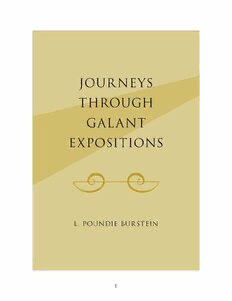
Journeys Through Galant Expositions PDF
Preview Journeys Through Galant Expositions
1 2 Journeys Through Galant Expositions 3 Journeys Through Galant Expositions L. POUNDIE BURSTEIN 4 Oxford University Press is a department of the University of Oxford. It furthers the University’s objective of excellence in research, scholarship, and education by publishing worldwide. Oxford is a registered trade mark of Oxford University Press in the UK and certain other countries. Published in the United States of America by Oxford University Press 198 Madison Avenue, New York, NY 10016, United States of America. © Oxford University Press 2020 All rights reserved. No part of this publication may be reproduced, stored in a retrieval system, or transmitted, in any form or by any means, without the prior permission in writing of Oxford University Press, or as expressly permitted by law, by license, or under terms agreed with the appropriate reproduction rights organization. Inquiries concerning reproduction outside the scope of the above should be sent to the Rights Department, Oxford University Press, at the address above. You must not circulate this work in any other form and you must impose this same condition on any acquirer. Library of Congress Cataloging-in-Publication Data Names: Burstein, L. Poundie, author. Title: Journeys through galant expositions / L. Poundie Burstein. Description: New York : Oxford University Press, 2020. | Includes bibliographical references and index. Identifiers: LCCN 2020014378 (print) | LCCN 2020014379 (ebook) | ISBN 9780190083991 (hardback) | ISBN 9780190084035 | ISBN 9780190084028 | ISBN 9780190084011 (epub) Subjects: LCSH: Sonata form. | Instrumental music—18th century—Analysis, appreciation. Classification: LCC MT62 .B87 2020 (print) | LCC MT62 (ebook) | DDC 784.18/3—dc23 LC record available at https://lccn.loc.gov/2020014378 LC ebook record available at https://lccn.loc.gov/2020014379 5 Contents Acknowledgments About the companion website 1. Introduction Parsing an exposition “Like Othello and Iago!” An alternate jelly-mould Journeys vs. containers Neo-Kochian approaches to form Packing for our journey I. THEORIES AND TERMINOLOGY 2. Formal Punctuations: Perioden and Sätze Punctuations and resting points Perioden Hauptperioden and Nebenperioden Sätze Resting points on the path toward the formal cadence Grad der Ruhe: degree of repose The Absatz as a leg of a journey Satz lengths Einschnitte Punctuation formulas Overview 6 Absatz-ending ≠ cadence A Schlußsatz must lead to a PAC, but a PAC ≠ the end of a Schlußsatz Where does it all end? Overhangs Appendices Satz-appendix, or Satz-beginning? Sätze in different keys Other formal terms for passages 3. Hauptruhepuncte and Haupttheile Avoiding Satz repetitions in the interpunctische Folge der Theile Repeated Absätze Appendices Absätze as “clarifications” Repeated and clarifying Absätze Parenthetic insertion (Einschiebsel) Rauschende and cantabile Quintabsätze 4. Eighteenth-Century Approaches to Expositions: Riepel and Koch Joseph Riepel In search of tonal order Riepel’s sample expositions The contrasting idea Aenderungsabsatz Koch Succession of resting points Resting points, not key areas Thematic character Energetic passage followed by a cantabile theme Contemporaneous writings 7 Other Eighteenth-Century Approaches to Expositions: Galeazzi, 5. Kollmann, and Neubauer Galeazzi Cadences and thematic character as formal elements Secondo Motivo can begin in either the home key or the key of V The “middle” theme Kollmann Neubauer Koch’s 1802 Musiklexikon 6. Modern Terminology First theme section vs. transition section Transition vs. secondary theme section Common criteria for determining secondary theme Thematic character Cadences and keys Direct motion to formal cadence The medial caesura and other textural markers Non-medial caesuras Other formal terms Closing section Continuous expositions; merged thematic functions II. EXPOSITIONS 7. Standard Punctuation Form The standard interpunctische Folge der Theile Mozart’s K. 282 redux 8. Two-Part Expositions A movement by Leopold Mozart A movement by his son 8 9. Division Following the Home-Key Dominant A two-part voyage Bifocal expositions where the main theme is repeated during the Quintabsatz Bifocal expositions with increasing momentum The lyrical “middle” passage Voice-leading frameworks for bifocal expositions Boundaries of secondary theme vs. middleground prolongation Portmann and Mozart’s K. 284 Mid-second theme break? Or dividing line between zones? 10. Division Following the New-Key Dominant Passage following the new-key half-cadential caesura Mid-transition demarcation on the home-key V Pre-medial caesuras Medial caesura declined followed by a chromatic passage Mid-transition break 11. Expositions with Two Half-Cadential Breaks The first movement of K. 43 Parsings following modern concepts Parsing following eighteenth-century concepts Double medial caesuras and the so-called trimodular block A hermeneutic strategy “Trimodular block” overview Expected motion to the EEC? Example from Haydn 12. Division Following Arrival on Tonic PAC appearing in the middle of a secondary theme section PAC appearing in the middle of or before the transition 9 New-key PAC appearing at the end of the transition Secondary themes that coincide with the Nebenperiode Home-key PAC appearing before the secondary theme 13. Uncommon Divisions Unusual resting points Repetitions (or apparent repetitions?) of Hauptruhepuncte Non-standard ordering of Hauptruhepuncte III. THE ENTIRE MOVEMENT 14. The Movement’s Second Half Development and recapitulation The final two Theile: eighteenth-century concepts Early double return Rotations through the thematic plan Where does the recapitulation “space” begin? The so-called false recapitulation 15. Analyses Johann Adolph Hasse, Overture to Alcide al Bivio, first movement (1760) First half of movement Second half of movement Marianna Martines, Sonata for Keyboard in A, first movement (c. 1765) First half of movement Second half of movement Joseph Haydn, Symphony No. 14 in A, first movement (c. 1762) First half of movement Second half of movement 10
